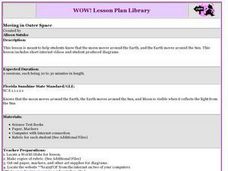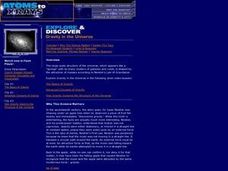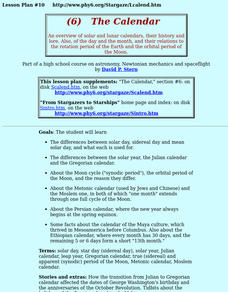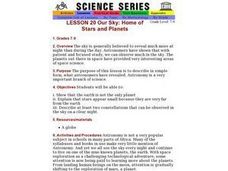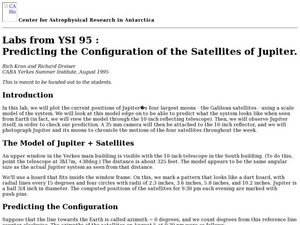Curated OER
Our Solar System - Comparing Planetary Travel Distances
NASA presents a mini-unit on distances in our solar system. It incorporates scientific concepts of gravity, mass, density, and payload while your aspiring astronauts also employ mathematics skills. They calculate speed, they determine...
BBC
Ourselves
Young biologists identify parts of the body, sort humans from other animals, and list the difference they see. Learners are split up into groups of three, and each group must find pictures in magazines of humans and other animals. They...
Curated OER
Soaring Through Space With a Kid Pix Slide Show
First graders create a slide show on Kid Pix about space. In this space lesson plan, 1st graders will explore the earth, sun, moon, and planets. After exploring their motions and locations around the sun, they create a 4 page slide show...
Curated OER
Stellar Lunar Curriculum
Students engage in a lesson about the moon and three different constellations. They conduct research using a variety of resources. The teacher leads the class with demonstrations and discussion groups. The research is also guided using...
Curated OER
Moving in Outer Space
Students participate in a lesson plan that demonstrates the concepts of rotation and revolution as they pertain to the Sun, the moon, and the Earth. They examine the relative sizes of each. They watch a computer based movie at a...
Curated OER
Retrograde Motion
Students study the motions of the heavenly bodies. In this space lesson students use models to show a variety of schemes explaining the motions.
Curated OER
The Moon is made of Cheese
Eighth graders explore the reasons why they believe scientific ideas are true. They think critically rather than accept everything they are told without question.
Curated OER
Craters!
Eighth graders examine the formation of craters. In this craters lesson, 8th graders discover the various energies involved in the formation of a crater, where you can find a crater in the Solar System, and observations of craters on the...
Curated OER
Nazis Flying Saucers – Film Sparks UFO Debate
Students explore the aircraft used in World War II. In this World History instructional activity, students read an article that describes a "flying saucer" created by the Nazi's. Upon completion of the reading, students answer questions...
Curated OER
Gravity In The Universe
Students assess and explore gravity in the Universe via several short video lessons. They analyze why this science matters and the history of Sir Isaac Newton's law of gravity. A variety of questions are asked within this lesson plan for...
Curated OER
Tides and How Creatures Survive
Learners discover tidal pools. In this oceanographic lesson, students observe the tides of the earth and the creatures that inhabit the intertidal zones. Learners role-play the tidal zones by portraying themselves as animals...
Curated OER
Watch This Space!
In this space worksheet, students, with a partner, answer five questions about the universe and read and discuss ten questions regarding astronomy.
Alabama Learning Exchange
Planetary Cereal Project
Sixth graders decorate an empty cereal box with information and games showing their comprehension of factual information about an assigned planet. This is a nice, creative lesson about the solar system.
Curated OER
What do You Know about Jupiter Already
Students explore information about the planet Jupiter. In this Jupiter instructional activity, students answer questions to find out how much they know about Jupiter. Students research using a website.
Curated OER
The Calendar
Pupils engage in an overview of solar and lunar calendars, their history and lore. Also, of the day and the month, and their relations to the rotation period of the Earth and the orbital period of the Moon.
Curated OER
Shadow Trackers
Students use online websites to inquire about the cycle of day and night. In this web based lesson, students are able to see the movement of the sun and Earth. Students can look at different parts of the Earth as if they were on the Sun...
Curated OER
Newton's Theory of Universal Gravitation
Young scholars explore how Newton tied together the gravity observed on Earth and the motion of the Moon. They apply an earlier lesson about centripetal forces.
Curated OER
Making a Crater
Students examine the characteristics of craters. In this crater lesson, students discover how meteors form craters on planets and moons as they make their own craters and respond to observational questions regarding the...
Curated OER
Our Sky: Home of Stars and Planets
Students discover that astronomy is a branch of science that includes the study of planets, stars, and constellations.
Curated OER
Remote Sensing - What Can We See When We Can't Touch?
Students discover how remote sensing is used to identify the signatures of life even when the particular life form is not directly observable. They investigate how a satellite "sees" objects on the surface of Earth.
Curated OER
Solar and Lunar Eclipses
Students examine eclipses. For this eclipse lesson, students investigate solar and lunar eclipses. Students complete a WebQuest and write a descriptive summary of eclipses. Lesson references a WebQuest, but does not include a link.
Curated OER
Predicting the Configuration of the Satellites of Jupiter
Young scholars plot the positions of the planet Jupiter while predicting what the configuration system looks like from Earth. In this configuration of satellites lesson, students photograph Jupiter and its moons to record the...
Curated OER
Our Solar System
Students study the Earth and Solar System through a variety of activities. They compile a coloring book show the characteristics of the Sun and nine planets.
Curated OER
What's Up? Astronomy Curriculum
Students study astronomy. In preparation for a field trip to a planetarium, students discuss the stars, planets, and light. They explore the importance of the north star and constellations. The Digitarium system is used to assist the...






